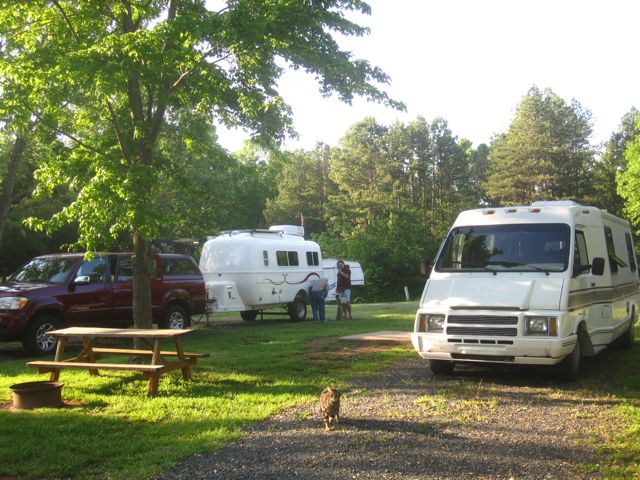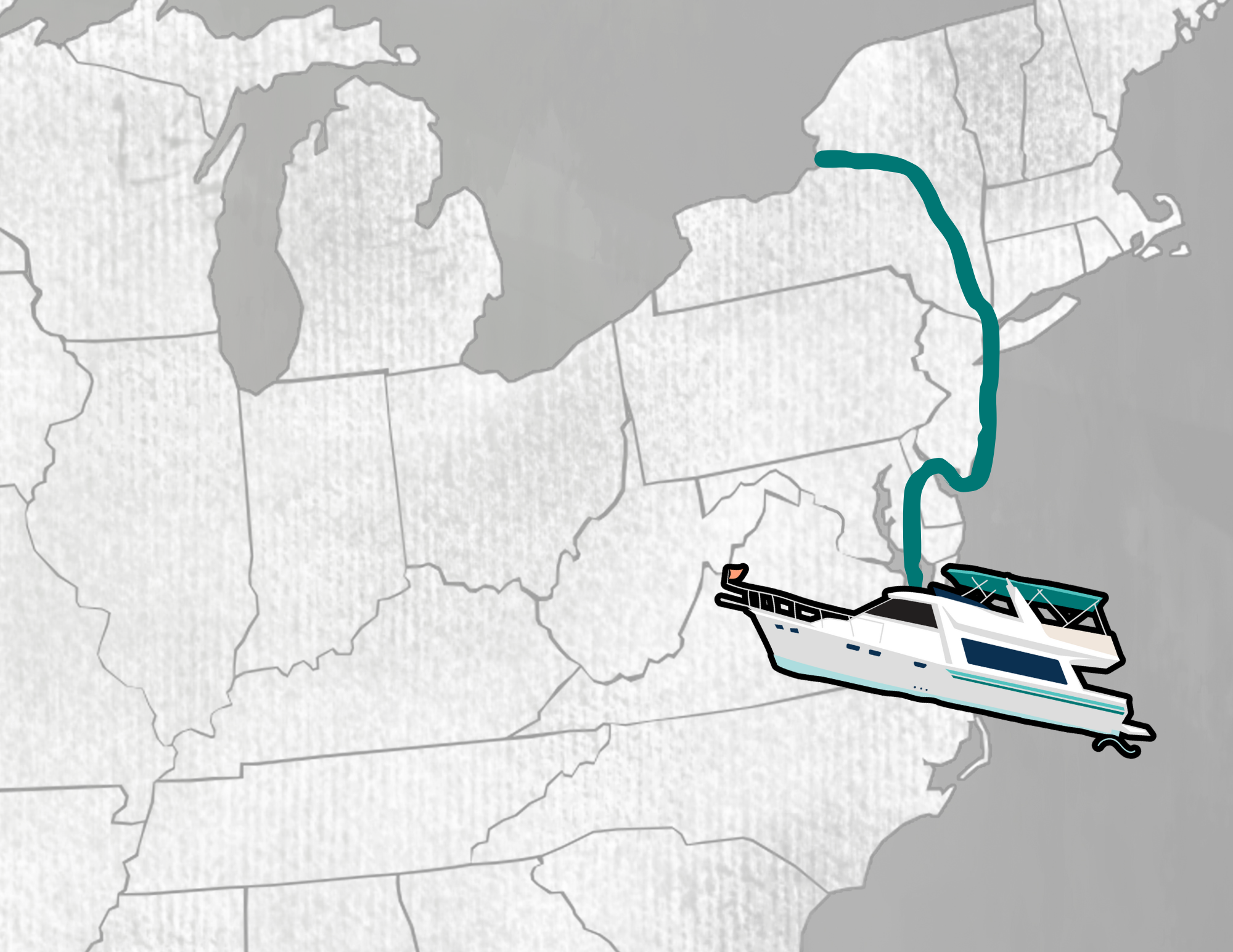Since we left Melbourne, Florida to head north to Lynchburg, Virginia to deliver the Oliver – we’ve been moving at a whirlwind pace. Heading up, we started a search for a temporary home on wheels – which yielded little acceptable results. In the southeast, so many sticks & stables RVs have suffered considerable water damage.
We then got a generous offer to borrow a small 1984 Winnebagao Le’Sharo from our friends Elloitt and Ann in Georgia. It’s tiny, maneuverable and gets high gas mileage. A bit smaller than we had our eyes on at 19′, and a lot of the systems not functioning (such a water and refrigeration) – but it’s been serving well as a moving van with a bed to continue our search in for a bit.
Our attention has shifted to researching smaller vintage buses (think 1950s and 1960s greyhound buses) as our next possible nomadic home on wheels. They seem to offer a nice balance of affordability (if you start out with a solid mechanical foundation), awesome style and quality. We’re amazed at the choices, range of features and amount of expertise we can tap into. We’ll follow-up soon with a post of the reasons why vintage buses have our eye for this next stage of our adventures.
Many in the bus nut communities have been super helpful in guiding us, and we’ve been invited to meet up with folks just to simply pick their brains and tour their buses. We’ve not been passing that up! We’ve also started looking at what is currently on the market, and touring some buses for sale in the northeast.
Our northeast tracking has also yielded opportunity to catch up with family and friends, and we even had an amazing nomadic rendezvous with Ben & Karen – who we hadn’t seen since last summer. They’re deep in their vintage bus conversion of a 1963 Flxible Starliner and we got to geek out in person about bus life.
It’s seeming that there are a lot of bus options westward, and the little Le’Sharo just won’t be ideal for much longer. So, we’re pointing westward this morning towards St. Louis where we can take advantage of storage space in Chris’ folks’ basement and leave our cat, Kiki, for a bit. We’ll then return the Le’Sharo to Georgia (with a stop in SC where I’ll teach a class for one of my clients).. and figure it out from there.
We’re thinking train trip to wherever the next bus candidate is.



Thanks for the many posts. Im considering the lifestyle and reading about others doing it is very helpful.
http://ourodyssey.blogspot.com/ is a blog of a couple that travels in a bus conversion volenteering for the red cross. They have lots of details on what they have and occasional references to the problems getting parts.
Thanks Blars.. we actually are friends of Sean & Louise’s and they have been helping us in our research and bus hunt. Well, at least before their most recent deployment, of course. They are indeed amazing resources.
” I can tell you fairly confidently that your fuel mileage with that age/configuration will be low single digits”……I’ve got a 1982 Detroit Diesel 6V92 Silver Turbo after cooled diesel in my 1982 Newell (30,000 gvw). It is an entirely mechanical engine…mechanical fuel injectors, etc….nothing electronic. I get, routinely 8 to 8.5 mpg pulling an enclosed car hauler….not exactly “low” single digits….actually pretty typical. No doubt some other vintage Cats and Cummins may get less, or more. How important fuel mileage is to any one person really is relative to your traveling style, and how much you wish, or plan to spend on fuel per month. If you stay in one place for a week, or two at a time then fuel consumption is lower on the totem pole. I can go about 1500 miles on a tank (180 gallons). My traveling style is 4-5 hundred miles a month…..so I can go 2, or 3 months, or more between fill ups. If you can’t, or don’t want to afford $250-300 a month for fuel(at today’s current diesel prices in California of over $4.00/gallon) then owning an RV of any kind is probably out of the question. If the bus conversion you settle on is ultimately equipped with solar panels, then you can save significantly on RV park charges by dry camping some, or all of the time.
Totally agreed, Clarke. In all of our research thus far – it seems fuel economy is coming in at 6 – 11 mpg for the models of 35′ buses we’re looking at. Variations of course for weight, auto vs. manual, turbo, towing, cruising speed, etc. For reference, our Tundra towing the Oliver got 11-12. And one has complete control over how much their fuel costs by adjusting the pace of travel. These types of fuel economies however are pretty darn good for RVs in this size range (ok.. really good), and aren’t concerning us all that much.
What is much more of a concern is the increased maintenance cost, and cost and unavailability of parts when you need them.
Let us know when you get to St. George, Utah. Christi and I would love to meet you two. My blog; http://singinglandcruiser.blogspot.com/
Thanks.. we just never know where Nomadic Serendipity will take us. Love St. George, gorgeous area.
Have you considered the fuel mileage of a bus that old, not to mention reliability?
Having experience with old heavy equipment I can tell you fairly confidently that your fuel mileage with that age/configuration will be low single digits, and breakdowns will result in long, agonizing delays and hunts for long scarce parts.
Although the nostalgia is there, I’m not sure the downsides are worth the possible pains, IMHO.
We are indeed researching and keeping these things in mind, as well as issues like rust & corrosion. Everyone has their threshold for what is worthwhile, and we are figuring out what ours is. Trust we’ll do our due diligence, as we do with every major decision we make in our lives. Thanks for your concern.
A vintage bus is an idea I wouldn’t have though of, but it sounds genius.
Genius and crazy are often hard to differentiate.. we’ll find out which
I have to admit that bus conversion (from Ben & Karen) looks mighty cool. Beautiful lines on that thing!
Oh.. I know, right? Baby got back.
Wow, what an adventure you two are on with this search! I’m excited to read your post on the merits of bus conversions; I know very little about them, but am very intrigued.
We’re amazed we’re on this search ourselves, but the more we research the more it feels right for us for now.
I found you a bus! Already converted ready to go.
http://gallery.me.com/ddlee/100047
It might need a little work, but look free delivery. You can see it on state highway 3 northwest of Watonga Oklahoma. If memory serves me it’s been parked in that spot for over 20 years.
Hah.. thanks!
No doubt someone has given you the advice to find a “bus” that either has been stored inside during the winter, and never driven on snow covered roads (where salt may cause corrosion), or to look for your next Rv home in the southwest where the air is dryer, where humidity, and corrosion are less of an issue. Exposure to high humidity for long periods of time can be a hidden enemy (mold, rot, fungus in diesel fuel tanks, etc.). Good luck in your search…will be following your adventures with great interest.
Yup yup, indeed.. these things are definitely on our radar.
We love traveling by train. I miss doing that since we moved into our RV. If you pay for a room you get meals included. In the diner you get seated with random people making for great conversations! I hope you enjoy as much as we have.
We’re looking forward to it, for sure